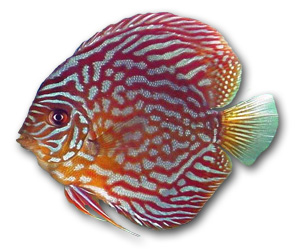Discus

Quick Stats
| Size | Up to 6" |
|---|---|
| Tank | 180 litres + |
| Swimming Area | All |
| Ph | 5.0 to 7.0 |
| Temperature | 79ºF to 88ºF (26-31°C) |
| Food | Live and specialised Discus food |
Common Name:
Discus.
Distribution:
Amazon Region.
Colouration:
Discus come in graceful pastel browns, reds and greens to vibrant and neon blues, orange and yellow. Discus can be colored in a pair, one solid, or a palette of colors. If you can imagine a color and characteristic, there is a good likelihood that someone out there breeds it.
Lifespan:
10 to 15 years.
Maintenance:
Water quality must be pristine. The water should be very soft and slightly acidic (2-3 degrees DH, pH about 6.5 ) older specimens can tolerate somewhat harder water. Frequent water changes are essentail. 10 to 20% weekly.
Feeding:
Feeding the Discus can be a frustrating experience. Live food should be varied and given at every occasion possible. Tubifex, Daphnia and brine shrimp are great choices.
Substrate:
The substrate should be dark and sandy to best appreciate their beautiful colours.
Tank Decor:
The tank must be large enough to give plenty of open space and also lots of places to hide. These shy fish like to retreat among bogwood or vegetation when disturbed. Plants in a Discus tank should be robust and reach up to the surface of the water. Bog roots and driftwood as well as clay flowerpots can be added also.
Filtration:
Water should be well filtered but not fast flowing.
Biotype:
Sections of deep, calm water with submerged trees in clear and White water in Amazonia The fish live in groups among the branches of these trees.
Breeding:
When well cared for and given a very varied diet these fish become sexually mature after about two to three years and will breed in the tank where they are being kept. They should never be transferred to a special breeding tank. A pair will separate themselves, usually during the spring, and chase the other fish as far as possible into a corner. Discus are typical open breeders with a quiet form of courtship and mating. The eggs are laid on rocks, more rarely on leaves, and they hatch in about 50 hours. Both parents tend the young, helping to "chew" them out of the egg membrane and transferring them to leaves. There they remain suspended by short filaments, are fanned by both the adults and finally start to swim after a further two to three days. In contrast to nearly all other fish the young feed not only on very tiny animals but also, and mainly, on a skin secretion produced by the parents This is produced by large one celled skin glands, mainly in the region of the back; these glands increase in number during the period of brood protection. The adults, and particularly the female, thus fulfill the function of a lactating cow. The fry do not in fact swim free very much, but attach themselves to the adults and suck at their skin. The parents alternate their duties at this time. The young will concentrate on one parent until a flip of its tail shakes them off and sends them to the other partner. Gradually, however, the young start to taken an increasing amount of small food from the open water, so they must be supplied with brine shrimp nauplii and rotifers. The young have a typical elongated fish shape, but soon become more rounded. They grow rather rapidly and by three months they are the typical Discus shape. The juvenile coloration changes to the definitive pattern after eight to nine months. Finally, it should be noted that Discus frequently eat their own eggs.